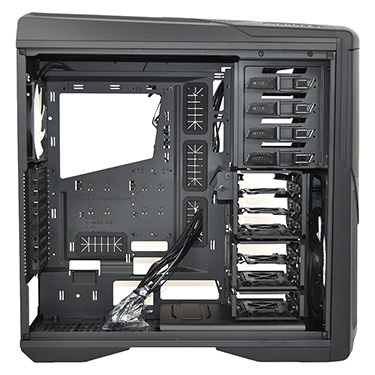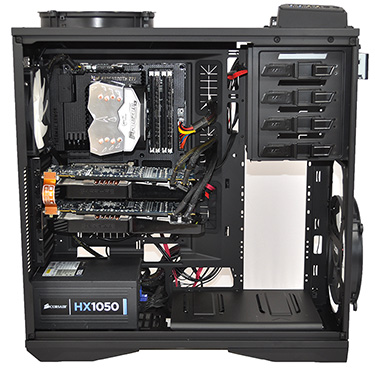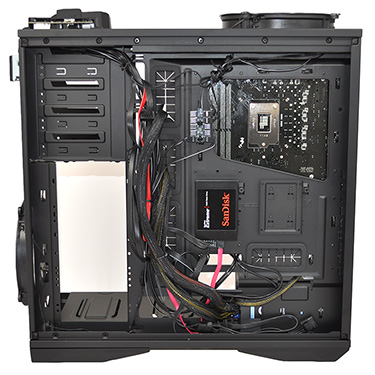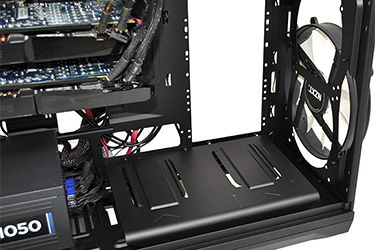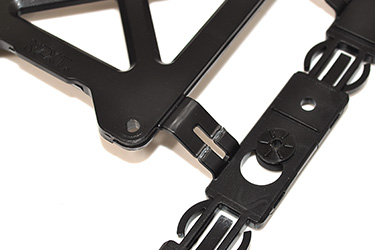Inside the Phantom 630
If there's one thing in particular that we always appreciate about NZXT Phantom chassis, it's that they're great fun to work with. Looking awesome and inviting on the inside has a lot to do with it, but they're also typically packed full of features that help make the build process as easy as possible.
However, while the Phantom 630 looks good, it isn't immediately as impressive as the premium Phantom 820. The number of rubber-grommeted cable-routing holes has been reduces from 10 to just four, the nine expansion slots no longer have thumb screws, and the fancy covers on the hard-disk column have been removed, giving the interior a more transparent look.
On the flip side, there are some noteworthy improvements. NZXT has added two dedicated 2.5in SSD mounts on the rear of the motherboard tray, and in addition to that, the hard-disk column is now modular in nature. The six available bays are spread across three cages (3, 2, 1) and they can be chopped and changed at will. What's particularly handy is that SSD-only builds can remove the drive cages altogether, freeing up a direct path for front-to-back airflow and, if you're partial to a bit of liquid cooling, opening up a large space for radiator/reservoir installation.
Our chassis test platform - consisting of an ASUS Z77 motherboard, an Intel Ivy Bridge processor and dual Radeon HD 7950 graphics cards - fits in very easily with more than enough cable-routing holes to maintain a tidy-looking build.
In keeping with the Phantom 820, the rear fan mount can be adjusted to align perfectly with your CPU cooler, and the PSU stands on raised rubber feet. Another minor improvement can be found on the optical bays, where the plastic tool-free attachments have been replaced by metal clips that feel noticeably more robust.
Surprisingly, one of our favourite features turns out to be the rear 2.5in SSD mounts. Provided in the form of two slide-out trays that lock via a thumbscrew, each mount is easily accessible and well-implemented. For an SSD-only build, having drives tucked away round back helps keep SATA cables out of view, and in providing dual 2.5in mounts, NZXT has left the door open for high-end RAID configurations.
The fan-controller hub that's attached to the rear of the motherboard tray also works well - it's handy having a central repository for up to 10 fans - but it does create a bit of extra cable clutter and the 200mm side intake fan isn't hard-wired, so you need to remember to unplug it before you pull the side panel clean off.
On the whole, many of the Phantom 630's features work well, and the build process can be simple and rewarding, albeit not entirely fault-free. We can think of two obvious criticisms. Firstly, and despite all the cable-routing opportunities, the holes designed to take cables up-and-over the motherboard tray are a very tight squeeze - our eight-pin CPU power connector simply wouldn't fit, forcing us to find another route.
Our second criticism lies with the 3.5in hard-disk trays. Though we're appreciative of the modular cages, the plastic trays found within are fragile and barely up to the task. Similar issues were present on the Phantom 820, and it's a shame to see that they haven't been remedied in the subsequent release.
We've found that the trays have a tendency not to stay in place, and if you fiddle with them too much they can begin to crack at the seams - as pictured above. On the other hand, if you're planning on removing the cages altogether, you'll be left with four 140mm mounts (two on the bottom, two up front) and lots of room for an elaborate water-cooled build.






